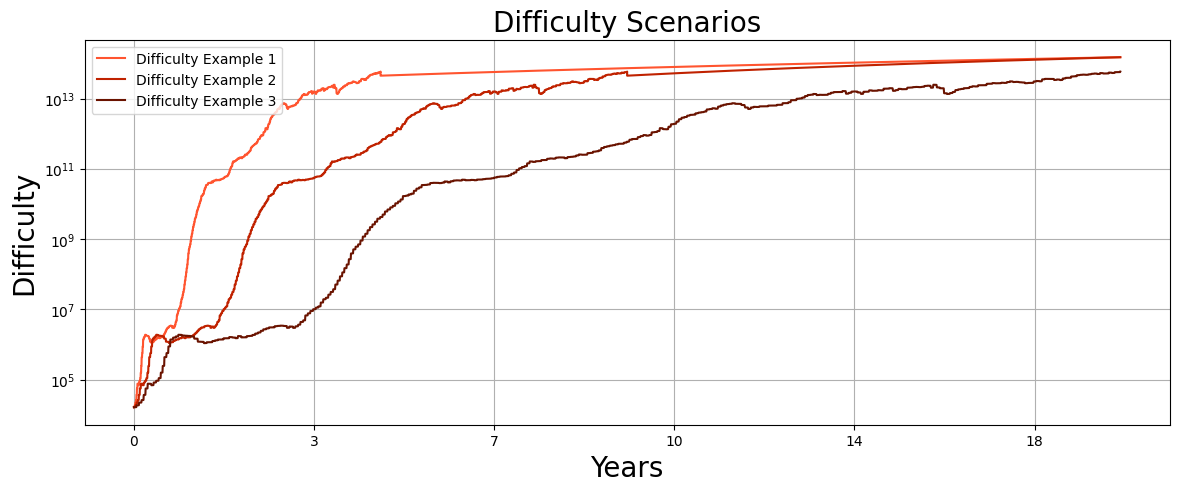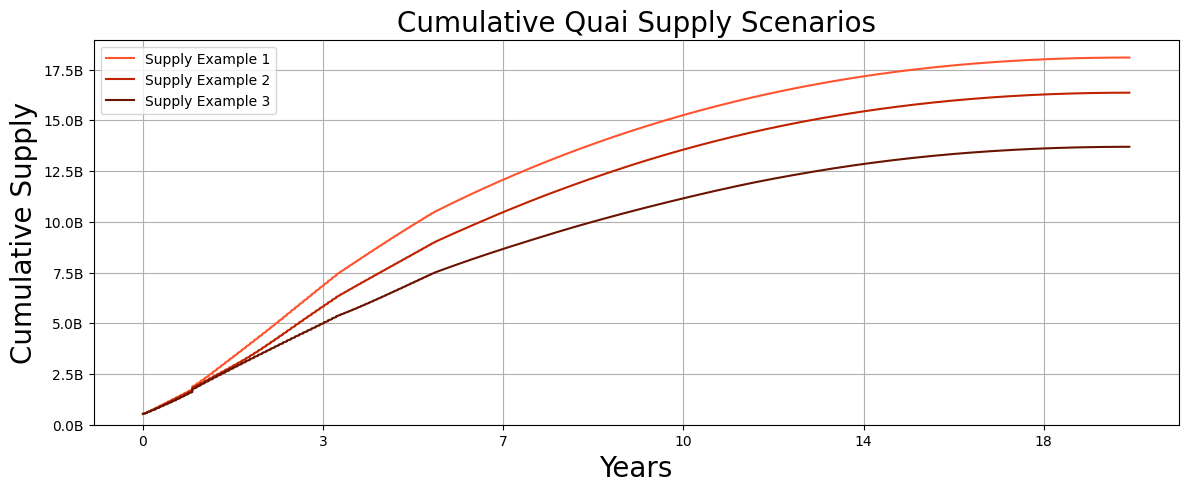Rethinking Token Emissions
Traditional cryptocurrencies use fixed emission schedules - Bitcoin’s famous 21 million cap being the prime example. While predictable, these rigid schedules often create artificial scarcity that leads to boom-bust cycles. When supply is fixed regardless of demand, prices can swing wildly, hindering practical adoption. Imagine if the Federal Reserve had to set money supply for the next 100 years today, regardless of economic growth or changing conditions. That’s essentially what fixed emission schedules do - they ignore market realities in favor of mathematical predictability. The Deflationary Challenge: For a store-of-value token to succeed long-term, its inflation rate must stay below the network’s growth rate. This creates natural scarcity where demand growth outpaces supply growth, driving sustainable value appreciation. The key is balancing scarcity with market responsiveness. Quai’s Market-Driven Approach: Instead of arbitrary time-based schedules, Quai lets market dynamics determine supply. The emission rate responds to real network conditions: hashrate, price discovery, and actual demand. This creates a more organic relationship between network growth and token supply.Network Value Theory & Emission Design
Network Value Growth Patterns: Research suggests that network systems typically follow predictable value growth patterns:- Early stage: Explosive n² growth as network effects compound
- Mature stage: Steady n×log(n) growth as expansion becomes more efficient
- Price discovery: Market determines fair value based on utility and demand
- Network hashrate: Security level reflects true network value
- Token utility: Actual usage drives sustainable demand
- Adaptive supply: Responds to changing network conditions
- Efficient allocation: Resources flow where they’re most valuable
- True value reflection: Supply matches actual network utility
- Reduced volatility: Eliminates artificial supply shocks from fixed schedules
Genesis Allocations: Fair Launch Foundation
Quai Network launches with a carefully structured initial allocation of 3 billion tokens. Unlike many projects that heavily favor insiders, Quai’s distribution prioritizes long-term network development and community growth. The genesis allocation balances several critical needs: funding continued development, rewarding early supporters, ensuring market liquidity, and building a robust ecosystem. Each allocation category has specific vesting schedules designed to align incentives with network success.
Unlock Schedule
| Team | 1 year cliff, monthly unlock over 36 months (years 1-4) |
| Investment Rounds | |
| - Seed 1 | 25% at TGE, 1 year cliff, monthly unlock over 36 months |
| - Seed 2 | 1 year cliff, 25% at cliff, monthly unlock over 36 months |
| - Strategic | 25% at TGE, 1 year cliff, monthly unlock over 36 months |
| Development Company | 25% at TGE, 6-month cliff, monthly unlock over 42 months |
| Foundation Reserve | 2% at TGE, 6-month cliff, monthly unlock over 66 months |
| Ecosystem & Community | 15% at TGE, 6-month cliff, monthly unlock over 42 months |
| Testnet & Earn Program | Earn Program Wave 1 & Testnet Rewards: 100% available at TGE Earn Program Wave 2 & 3: 25% on first distribution, monthly unlock for 24 months Remaing allocation burned |
| Exchange/Market Making | 100% available at TGE |
Foundation (33%)
Purpose: Maximize adoption of the Quai protocol. 2% released at TGE with a 6-month cliff, followed by monthly unlocks over 66 months to fund future innovations, partnerships, and ecosystem growth.Community Incentives (23%)
Purpose: To encourage and reward active participation and contribution from the community. 15% released at TGE with a 6-month cliff, followed by monthly unlocks over 42 months, with predefined criteria to ensure fair distribution.Team (16%)
Purpose: To reward and retain talented team members. Tokens have a 1-year cliff followed by monthly unlocks over 36 months (years 1-4) to attract and retain top talent committed to the project.Investment Rounds (14%)
Purpose: To provide capital for development and growth.- Seed 1 Investors (10%): 25% released at TGE with a 1-year cliff, followed by monthly unlocks over 36 months.
- Seed 2 Investors (2%): 25% released at 1-year cliff, followed by monthly unlocks over 36 months.
- Strategic Investors (2%): 25% released at TGE with a 1-year cliff, followed by monthly unlocks over 36 months to align with entities providing strategic value.
Development Company (6%)
Purpose: To fund ongoing protocol development. 25% released at TGE with a 6-month cliff, followed by monthly unlocks over 42 months to support sustainable development efforts.Testnet & Earn Program (5%)
Purpose: To incentivize participation in the testnet phase for debugging and optimizing the network. 100% available at TGE with approximately 70M tokens to be burned, ensuring a well-tested network before full deployment.Exchange Liquidity (2%)
Purpose: To provide liquidity on exchanges for the project’s token. 100% available at TGE to enable easy trading and fair pricing, crucial for attracting new users and investors.Quai Block Rewards
Quai rewards are issued in proportion to the “bits” of difficulty that a valid block hash achieved, approximately represented by the number of leading zeros in the target value. Note that there is a proportionality constant/variable in the Quai block reward function above. It is currently set at 221077819000000000. This proportinality variable will evolve with the launch of Qi, becoming more dynamic through the controller system for Quai/Qi conversions.Quai Supply
The supply of Quai is determined by the following formula: The block reward function only defines how many Quai tokens can potentially be emitted. Actual, realized supply emissions from block rewards are determined by the choices miners must make to receive only either Quai or Qi, a selection they may change going forward at any time. In addition to the effects from this new flow of Quai and/or Qi issuance, the respective supply stock of Quai is affected by the initial genesis allocation of Quai and the conversion feature between existing Qi and Quai at the current block mining rewards ratio (e.g. between the # of Quai tokens/block and # of Qi tokens/block), which is accessible to anyone — not just miners. As such, the supply of Quai at any given time is the cumulative result of the genesis allocation, miner-selected emissions, and token conversions. These illustrative examples assume:- Miners take 100% of block reward in Quai rather than any in Qi, and that there is no net effect of conversions between the two.
- Varying network difficulty growth rates based on Bitcoin’s growth:
- Example 1: Bitcoin’s growth from 2011 through 2023, extrapolating that same growth rate over an additional 7 years.
- Example 2: Bitcoin’s growth from 2011 through 2023, but spreads it out over 20 years.
- Example 3: Bitcoin’s growth between 2011 through 2016, spread out over 20 years.



